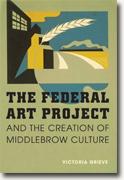The Federal Art Project and the Creation of Middlebrow Culture
Victoria Grieve
book reviews:
· general fiction
· chick lit/romance
· sci-fi/fantasy
· graphic novels
· nonfiction
· audio books
· author interviews
· children's books @
curledupkids.com
· DVD reviews @
curledupdvd.com
newsletter
win books
buy online
links
home
for authors
& publishers
for reviewers

 |
The Federal Art Project and the Creation of Middlebrow Culture Victoria Grieve University of Illinois Press Hardcover 240 pages March 2009 |
|
In the 1930s, America was seeking its identity as a fully-fledged country no longer dependent on European culture and values. Radical artists wanted to delve into purely American subject matter, to be recognized and rewarded for work that showed the true American character rather than imitating classical forms from the past and from other places. This longing for a uniquely American zeitgeist was part and parcel of the New Deal’s Federal Art Project.
The Federal Arts Project played into these philosophical streams by encouraging paintings, posters, sculptures, and mosaics that depicted strongly American themes. The slogan was “buy American art,” and it worked. What happened in the process was the creation of a new consciousness of decoration and music that harked back to an authentic not-so-distant past. It broadened the influence of fine arts to include the rising middle class, the “middlebrow” art fans. The people’s art was suddenly out of the purview of the sophisticated upper classes; it belonged to those who could understand and access it without a textbook. The new arts embodied simplicity, strength, moral purpose and nostalgia. According to author, curator and professor Victoria Grieve in this extensively researched highly detailed treatise, “numbers prove that during the 1930s, more Americans saw original art, participated in art classes, experienced live theater and heard symphonic music as a result of the New Deal cultural programs.” The artists of the era influenced the next generation stylistically and philosophically. The FAP also brought government into the arts world, a trend which doubtless saw its height in the Kennedy presidency. However, there has since been a retreat and a diminution of funding from government sources as artists have begun to recapture their status as progenitors of works designed for the exclusive appreciation of highbrow critics. In this reviewer’s opinion, the current middlebrow audience is not finding aesthetic satisfaction in the creations of these superior beings but in more accessible media such as mass art reproductions, the Internet, and home theaters. Originally published on Curled Up With A Good Book at www.curledup.com. © Barbara Bamberger Scott, 2009 |
|
|
|
 Click here to learn more about this month's sponsor! |
|
| fiction · sf/f · comic books · nonfiction · audio newsletter · free book contest · buy books online review index · links · · authors & publishers reviewers |
|
| site by ELBO Computing Resources, Inc. | |
 Progressives were already aware that art needed to be brought to the masses. There was a prevalent belief that artists were special people, above the fray, who could endow their gifts of insight on other, lesser-developed, beings. Jane Addams and her lifelong friend John Dewey staged art shows in which the benighted poor were brought in to view and be uplifted. If it sounds naïve, it probably was, but it was well-intentioned and posited a world view which most artists shared. Addams and others also sought to promote “folk arts” such as sewing, woodcraft, weaving, and décor. Sarah Gertrude Knott provided the impetus for the First National Folk Festival in 1934. Her conviction was that “‘grassroots expressions which had served pioneer forefathers’ could be sources for recreation and education in the modern world.” This seemingly backward approach, taking folk arts out of the hands of indigenous craftsmen and putting them in the hands of the more affluent and less talented, also seems naïve and indeed counterproductive. But again, these ideas were sincerely held by people whose goal was to glorify the American folk soul.
Progressives were already aware that art needed to be brought to the masses. There was a prevalent belief that artists were special people, above the fray, who could endow their gifts of insight on other, lesser-developed, beings. Jane Addams and her lifelong friend John Dewey staged art shows in which the benighted poor were brought in to view and be uplifted. If it sounds naïve, it probably was, but it was well-intentioned and posited a world view which most artists shared. Addams and others also sought to promote “folk arts” such as sewing, woodcraft, weaving, and décor. Sarah Gertrude Knott provided the impetus for the First National Folk Festival in 1934. Her conviction was that “‘grassroots expressions which had served pioneer forefathers’ could be sources for recreation and education in the modern world.” This seemingly backward approach, taking folk arts out of the hands of indigenous craftsmen and putting them in the hands of the more affluent and less talented, also seems naïve and indeed counterproductive. But again, these ideas were sincerely held by people whose goal was to glorify the American folk soul.